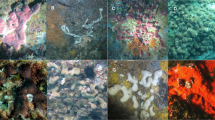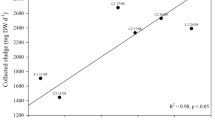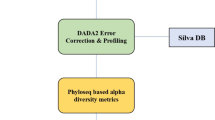Abstract
Seriola rivoliana intestinal microbiota (IM) was characterised under aquaculture conditions through 16S rRNA amplicon sequencing. Specimens of 30 days after hatching (DAH) were maintained in three tanks and fed under the same environmental conditions for characterisation 15 days prior to sampling. Three fish were randomly taken from each tank; total DNA extraction of the gut microbiota was performed to characterise microbial composition and its metabolic prediction. The V3 hypervariable region of the 16S rRNA was amplified and sequenced with Illumina pair-end technology. The prokaryotic components in the S. rivoliana intestine were dominated mainly by the phyla Proteobacteria, Firmicutes, Bacteroidetes, Cyanobacteria and Actinobacteria. No significant differences in beta diversity were detected in the three samples (tanks). However in alpha diversity, they were detected in juveniles of the same cohort within the same group, as exemplified by enrichment of certain bacterial groups, mainly of the Clostridia class, which were specific in each fish within the same tank. The metabolic prediction analyses suggested that S. rivoliana IM contribute to the metabolism of amino acids, carbohydrates, lipids, and immune system. This study provides the first IM characterisation under rearing conditions of S. rivoliana—a species with broad economic potential—and contributes to novel information for potential use of probiotics in future trials.




Similar content being viewed by others
References
Kissinger KR, García-Ortega A, Trushenski JT (2016) Partial fish meal replacement by soy protein concentrate, squid and algal meals in low fish-oil diets containing Schizochytrium limacinum for longfin yellowtail Seriola rivoliana. Aquaculture 452:37–44. https://doi.org/10.1016/j.aquaculture.2015.10.022
Sicuro B, Luzzana U (2016) The state of Seriola spp. other than yellowtail (S. quinqueradiata) farming in the world. Rev Fish Sci Aquac 24:314–325
Roo J, Fernández-Palacios H, Hernández-Cruz CM et al (2014) First results of spawning and larval rearing of longfin yellowtail Seriola rivoliana as a fast-growing candidate for European marine finfish aquaculture diversification. Aquac Res 45:689–700. https://doi.org/10.1111/are.12007
Teles A, Salas-Leiva J, Alvarez-González CA et al (2017) Histological study of the gastrointestinal tract in longfin yellowtail (Seriola rivoliana) larvae. Fish Physiol Biochem 43:1613–1628. https://doi.org/10.1007/s10695-017-0397-5
Teles A, Salas-Leiva J, Alvarez-González CA, Tovar-Ramírez D (2018) Changes in digestive enzyme activities during early ontogeny of Seriola rivoliana. Fish Physiol Biochem 45(2):733–742
Benitez-Hernández A, Jiménez-Bárcenas SPL, Sánchez-Gutiérrez EY et al (2017) Use of marine by-product meals in diets for juvenile longfin yellowtail Seriola rivoliana. Aquac Nutr 24:562–570. https://doi.org/10.1111/anu.12588
Le DuJ, Tovar-Ramírez D, Núñez-Vázquez EJ et al (2017) Embryotoxic effects of dissolved okadaic acid on the development of Longfin yellowtail Seriola rivoliana. Aquat Toxicol 190:210–216. https://doi.org/10.1016/j.aquatox.2017.07.012
Fernández-Palacios H, Schuchardt D, Roo J et al (2015) Spawn quality and GnRHa induction efficiency in longfin yellowtail (Seriola rivoliana) broodstock kept in captivity. Aquaculture 435:167–172
Mazón-Suástegui JM, Salas-Leiva J, Teles A, Tovar-Ramírez D (2018) Immune and antioxidant enzyme response of Longfin yellowtail (Seriola rivoliana) juveniles to ultra-diluted substances derived from phosphorus, silica and pathogenic vibrio. Homeopathy 108(01):043–053
Mesa-Rodríguez A, Hernández-Cruz CM, Betancor MB et al (2016) Bone development of the skull, pectoral and pelvic fins in Seriola rivoliana (Valenciennes, 1833) larvae. Fish Physiol Biochem 42:1777–1789. https://doi.org/10.1007/s10695-016-0257-8
Mesa-Rodríguez A, Hernández-Cruz CM, Socorro JA et al (2014) Skeletal development and mineralization pattern of the vertebral column, dorsal, anal and caudal fin complex in Seriola rivoliana (Valenciennes, 1833) larvae. J Aquac Res Dev. https://doi.org/10.4172/2155-9546.1000266
Clements KD, Angert ER, Montgomery WL, Choat JH (2014) Intestinal microbiota in fishes: what’s known and what’s not. Mol Ecol 23:1891–1898. https://doi.org/10.1111/mec.12699
Montalban-Arques A, De Schryver P, Bossier P et al (2015) Selective manipulation of the gut microbiota improves immune status in vertebrates. Front Immunol 6:512. https://doi.org/10.3389/fimmu.2015.00512
Tarnecki AM, Burgos FA, Ray CL, Arias CR (2017) Fish intestinal microbiome: diversity and symbiosis unravelled by metagenomics. J Appl Microbiol 123:2–17. https://doi.org/10.1111/jam.13415
Ghanbari M, Kneifel W, Domig KJ (2015) A new view of the fish gut microbiome: advances from next-generation sequencing. Aquaculture 448:464–475
Aguilera E, Yany G, Romero J (2013) Cultivable intestinal microbiota of yellowtail juveniles (Seriola lalandi) in an aquaculture system. Lat Am J Aquat Res 41:395–403
Soriano EL, Ramírez DT, Araujo DR et al (2018) Effect of temperature and dietary lipid proportion on gut microbiota in yellowtail kingfish Seriola lalandi juveniles. Aquaculture 497:269–277
Ramírez C, Romero J (2017a) The microbiome of Seriola lalandi of wild and aquaculture origin reveals differences in composition and potential function. Front Microbiol 8:1844
Wilkes Walburn J, Wemheuer B, Thomas T et al (2019) Diet and diet-associated bacteria shape early microbiome development in Yellowtail Kingfish (Seriola lalandi). Microb Biotechnol 12:275–288
Ley RE, Hamady M, Lozupone C et al (2008) Evolution of mammals and their gut microbes. Science 320:1647–1651
Sullam KE, Essinger SD, Lozupone CA et al (2012) Environmental and ecological factors that shape the gut bacterial communities of fish: a meta-analysis. Mol Ecol 21:3363–3378. https://doi.org/10.1111/j.1365-294X.2012.05552.x
Wong S, Rawls JF (2012) Intestinal microbiota composition in fishes is influenced by host ecology and environment. Mol Ecol 21:3100–3102
Bevins CL, Salzman NH (2011) The potter’s wheel: the host’s role in sculpting its microbiota. Cell Mol Life Sci 68:3675
Navarrete P, Magne F, Araneda C et al (2012) PCR-TTGE analysis of 16S rRNA from rainbow trout (Oncorhynchus mykiss) gut microbiota reveals host-specific communities of active bacteria. PLoS ONE 7:e31335
David LA, Maurice CF, Carmody RN et al (2014) Diet rapidly and reproducibly alters the human gut microbiome. Nature 505:559
Langille MGI, Zaneveld J, Caporaso JG et al (2013) Predictive functional profiling of microbial communities using 16S rRNA marker gene sequences. Nat Biotechnol 31:814
Douglas GM, Maffei VJ, Zaneveld J et al (2019) PICRUSt2: an improved and extensible approach for metagenome inference. BioRxiv. https://doi.org/10.1101/672295
Iwai S, Weinmaier T, Schmidt BL et al (2016) Piphillin: improved prediction of metagenomic content by direct inference from human microbiomes. PLoS ONE 11:e0166104
Wilkinson TJ, Huws SA, Edwards JE et al (2018) CowPI: a rumen microbiome focussed version of the PICRUSt functional inference software. Front Microbiol 9:1095
Jun S-R, Robeson MS, Hauser LJ et al (2015) PanFP: pangenome-based functional profiles for microbial communities. BMC Res Notes 8:479
Aßhauer KP, Wemheuer B, Daniel R, Meinicke P (2015) Tax4Fun: predicting functional profiles from metagenomic 16S rRNA data. Bioinformatics 31:2882–2884
Ortiz-Estrada ÁM, Gollas-Galván T, Martínez-Córdova LR, Martínez-Porchas M (2019) Predictive functional profiles using metagenomic 16S rRNA data: a novel approach to understanding the microbial ecology of aquaculture systems. Rev Aquac 11:234–245
Sambrook J, Fritsch EF, Maniatis T (1989) Molecular cloning: a laboratory manual. Cold Spring Harbor Laboratory Press, Cold Spring Harbor
Huse SM, Dethlefsen L, Huber JA et al (2008) Exploring microbial diversity and taxonomy using SSU rRNA hypervariable tag sequencing. PLoS Genet 4:e1000255
Edgar RC (2013) UPARSE: highly accurate OTU sequences from microbial amplicon reads. Nat Methods 10:996
Caporaso JG, Kuczynski J, Stombaugh J et al (2010) QIIME allows analysis of high-throughput community sequencing data. Nat Methods 7:335
Comeau AM, Douglas GM, Langille MGI (2017) Microbiome helper: a custom and streamlined workflow for microbiome research. MSystems 2:e00127-e216
Martin M (2011) Cutadapt removes adapter sequences from high-throughput sequencing reads. EMBnet J 17:10
Zhang J, Kobert K, Flouri T, Stamatakis A (2013) PEAR: a fast and accurate Illumina Paired-End reAd mergeR. Bioinformatics 30:614–620
Schloss PD, Gevers D, Westcott SL (2011) Reducing the effects of PCR amplification and sequencing artifacts on 16S rRNA-based studies. PLoS ONE 6:e27310
Lex A, Gehlenborg N, Strobelt H et al (2014) UpSet: visualization of intersecting sets. IEEE Trans Visual Comput Graphics 20:1983–1992
Hammer Ø, Harper DAT, Ryan PD (2001) Paleontological statistics software: package for education and data analysis. Palaeontol Electron 4:9
Vázquez-Baeza Y, Pirrung M, Gonzalez A, Knight R (2013) EMPeror: a tool for visualizing high-throughput microbial community data. Gigascience 2:16
Llewellyn MS, Boutin S, Hoseinifar SH, Derome N (2014) Teleost microbiomes: the state of the art in their characterization, manipulation and importance in aquaculture and fisheries. Front Microbiol 5:207
Xia JH, Lin G, Fu GH et al (2014) The intestinal microbiome of fish under starvation. BMC Genomics 15:266
Merrifield DL, Rodiles A (2015) The fish microbiome and its interactions with mucosal tissues. Mucosal health in aquaculture. Elsevier, Amsterdam, pp 273–295
Zhang J, Zheng H, Li Y et al (2016) Coexpression network analysis of the genes regulated by two types of resistance responses to powdery mildew in wheat. Sci Rep 6:23805
Wang AR, Ran C, Ringø E, Zhou ZG (2017) Progress in fish gastrointestinal microbiota research. Rev Aquac 10(3):626–634
Ingerslev H-C, von Gersdorff JL, Strube ML et al (2014) The development of the gut microbiota in rainbow trout (Oncorhynchus mykiss) is affected by first feeding and diet type. Aquaculture 424:24–34
Gajardo K, Rodiles A, Kortner TM et al (2016) A high-resolution map of the gut microbiota in Atlantic salmon (Salmo salar): a basis for comparative gut microbial research. Sci Rep 6:30893
Zarkasi KZ, Taylor RS, Abell GCJ et al (2016) Atlantic salmon (Salmo salar L.) gastrointestinal microbial community dynamics in relation to digesta properties and diet. Microb Ecol 71:589–603
Kim D-H, Kim D (2013) Microbial diversity in the intestine of olive flounder (Paralichthys olivaceus). Aquaculture 414:103–108
Wong S, Waldrop T, Summerfelt S et al (2013) Aquacultured rainbow trout (Oncorhynchus mykiss) possess a large core intestinal microbiota that is resistant to variation in diet and rearing density. Appl Environ Microbiol 79:4974–4984
Llewellyn MS, McGinnity P, Dionne M et al (2015) The biogeography of the atlantic salmon (Salmo salar) gut microbiome. ISME J 10:1280
Bledsoe JW, Peterson BC, Swanson KS, Small BC (2016) Ontogenetic characterization of the intestinal microbiota of channel catfish through 16S rRNA gene sequencing reveals insights on temporal shifts and the influence of environmental microbes. PLoS ONE 11:e0166379
Colston TJ, Jackson CR (2016) Microbiome evolution along divergent branches of the vertebrate tree of life: what is known and unknown. Mol Ecol 25:3776–3800
Fortes-Silva R, Oliveira IE, Vieira VP et al (2016) Daily rhythms of locomotor activity and the influence of a light and dark cycle on gut microbiota species in tambaqui (Colossoma macropomum). Biol Rhythm Res 47:183–190
Ye L, Amberg J, Chapman D et al (2014) Fish gut microbiota analysis differentiates physiology and behavior of invasive Asian carp and indigenous American fish. ISME J 8:541
Utami YD, Kuwahara H, Igai K et al (2018) Genome analyses of uncultured TG2/ZB3 bacteria in ‘Margulisbacteria’specifically attached to ectosymbiotic spirochetes of protists in the termite gut. ISME J 13(2):455–467
Utami YD, Kuwahara H, Murakami T et al (2018) Phylogenetic diversity and single-cell genome analysis of “Melainabacteria”, a non-photosynthetic cyanobacterial group, in the termite gut. Microbes Environ 33:50–57
Ramírez C, Romero J (2017b) Fine flounder (Paralichthys adspersus) microbiome showed important differences between wild and reared specimens. Front Microbiol 8:271
Austin B (2006) The bacterial microflora of fish, revised. Sci World J 6:931–945
Schmidt VT, Smith KF, Melvin DW, Amaral-Zettler LA (2015) Community assembly of a euryhaline fish microbiome during salinity acclimation. Mol Ecol 24:2537–2550
Yan Q, Li J, Yu Y et al (2016) Environmental filtering decreases with fish development for the assembly of gut microbiota. Environ Microbiol 18:4739–4754
Dehler CE, Secombes CJ, Martin SAM (2017) Environmental and physiological factors shape the gut microbiota of Atlantic salmon parr (Salmo salar L.). Aquaculture 467:149–157
Fjellheim AJ, Playfoot KJ, Skjermo J, Vadstein O (2012) Inter-individual variation in the dominant intestinal microbiota of reared Atlantic cod (Gadus morhua L.) larvae. Aquac Res 43:1499–1508
Gatesoupe F, Covès D, Ortega A et al (2013) A spatiotemporal study of bacterial community profiles associated with Atlantic bluefin tuna larvae, Thunnus thynnus L., in three Mediterranean hatcheries. Aquac Res 44:1511–1523
Giatsis C, Sipkema D, Smidt H et al (2014) The colonization dynamics of the gut microbiota in tilapia larvae. PLoS ONE 9:e103641
Li XM, Zhu YJ, Yan QY et al (2014) Do the intestinal microbiotas differ between paddlefish (Polyodon spathala) and bighead carp (Aristichthys nobilis) reared in the same pond? J Appl Microbiol 117:1245–1252
Li T, Long M, Gatesoupe F-J et al (2015) Comparative analysis of the intestinal bacterial communities in different species of carp by pyrosequencing. Microb Ecol 69:25–36
Datta MS, Almada AA, Baumgartner MF et al (2018) Inter-individual variability in copepod microbiomes reveals bacterial networks linked to host physiology. ISME J 12(9):2103–2113
Tracy BP, Jones SW, Fast AG et al (2012) Clostridia: the importance of their exceptional substrate and metabolite diversity for biofuel and biorefinery applications. Curr Opin Biotechnol 23:364–381
Clements KD, Pasch IBY, Moran D, Turner SJ (2007) Clostridia dominate 16S rRNA gene libraries prepared from the hindgut of temperate marine herbivorous fishes. Mar Biol 150:1431–1440
Eichmiller JJ, Hamilton MJ, Staley C et al (2016) Environment shapes the fecal microbiome of invasive carp species. Microbiome 4:44
Booijink CCGM, El-Aidy S, Rajilić-Stojanović M et al (2010) High temporal and inter-individual variation detected in the human ileal microbiota. Environ Microbiol 12:3213–3227
Mardinoglu A, Shoaie S, Bergentall M et al (2015) The gut microbiota modulates host amino acid and glutathione metabolism in mice. Mol Syst Biol 11:834
Ray AK, Ghosh K, Ringø E (2012) Enzyme-producing bacteria isolated from fish gut: a review. Aquac Nutr 18:465–492
Wang G, Huang S, Wang Y et al (2019) Bridging intestinal immunity and gut microbiota by metabolites. Cell Mol Life Sci 76:3917–3937
Nicholson JK, Holmes E, Kinross J et al (2012) Host-gut microbiota metabolic interactions. Science 336(6086):1262–1267
Lin L, Zhang J (2017) Role of intestinal microbiota and metabolites on gut homeostasis and human diseases. BMC Immunol 18:2
Laing KJ, Purcell MK, Winton JR, Hansen JD (2008) A genomic view of the NOD-like receptor family in teleost fish: identification of a novel NLR subfamily in zebrafish. BMC Evol Biol 8:42
Acknowledgements
To CIBNOR staff for their technical support: Patricia Hinojosa Baltazar, Ángel Hernández-Contreras, Marcos Quiñones and Milagro García. To Kampachi Farms for providing fertilized eggs for the study. The authors want to especially thank D.E. Salas-Leiva from the Centre for Comparative Genomics and Evolutionary Bioinformatics (CGEB), for her insightful recommendations for data analyses; D. Fischer for editorial services in English.
Funding
To Sectoral Fund for Research and Education of México, projects CB-CONACyT No. 258282 and No. 157763 under the academic responsibilities of J.M.S. and D.T.R., respectively. A.T. and J.S.L., received doctoral (CONACyT 335728) and post-doctoral (CIB-PRY-20256) fellowships, respectively.
Author information
Authors and Affiliations
Contributions
JSL, JMS and DTR, conceived and designed research; JSL and AT, conducted experiments; JSL, performed bioinformatics analysis; JSL and DTR, contributed reagents or analytical tools; JSL, JMS and DTR, analysed data; JSL and DTR, wrote the manuscript; All authors read and approved the manuscript.
Corresponding author
Ethics declarations
Conflict of interest
The authors declare that they have no known competing financial interests or personal relationships that could have appeared to influence the work reported in this paper.
Ethical approval
The experiment complied with the Guidelines of the European Union Council (2010/63/EU) and the Mexican Government (NOM-062—ZOO-1999) for the production, care, and use of experimental animals, and with the ARRIVE guidelines.
Additional information
Publisher's Note
Springer Nature remains neutral with regard to jurisdictional claims in published maps and institutional affiliations.
Rights and permissions
About this article
Cite this article
Salas-Leiva, J., Mazón-Suástegui, J.M., Teles, A. et al. Structure and predictive metabolic contribution of intestinal microbiota of Longfin yellowtail (Seriola rivoliana) juveniles in aquaculture systems. Mol Biol Rep 47, 9627–9636 (2020). https://doi.org/10.1007/s11033-020-05970-x
Received:
Accepted:
Published:
Issue Date:
DOI: https://doi.org/10.1007/s11033-020-05970-x




